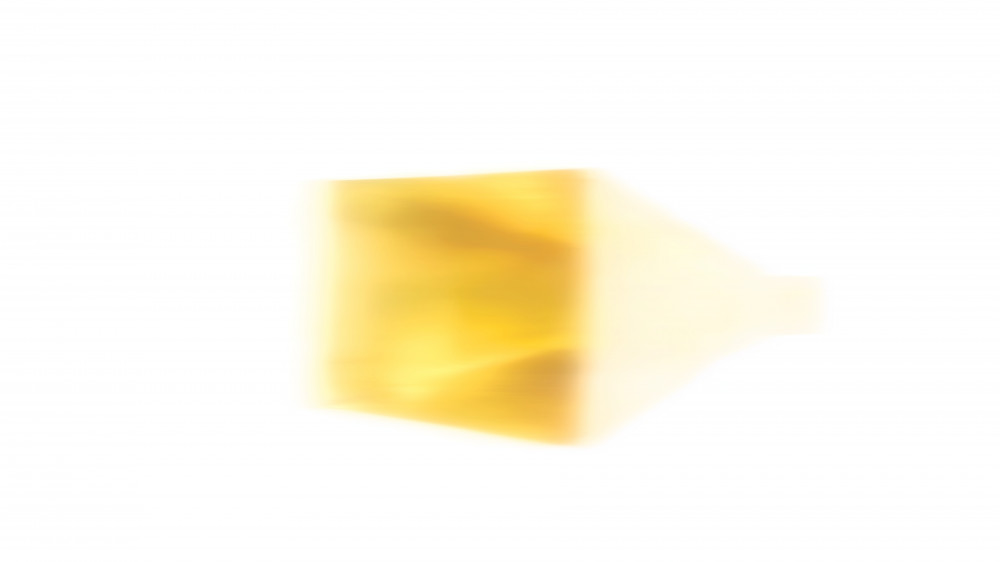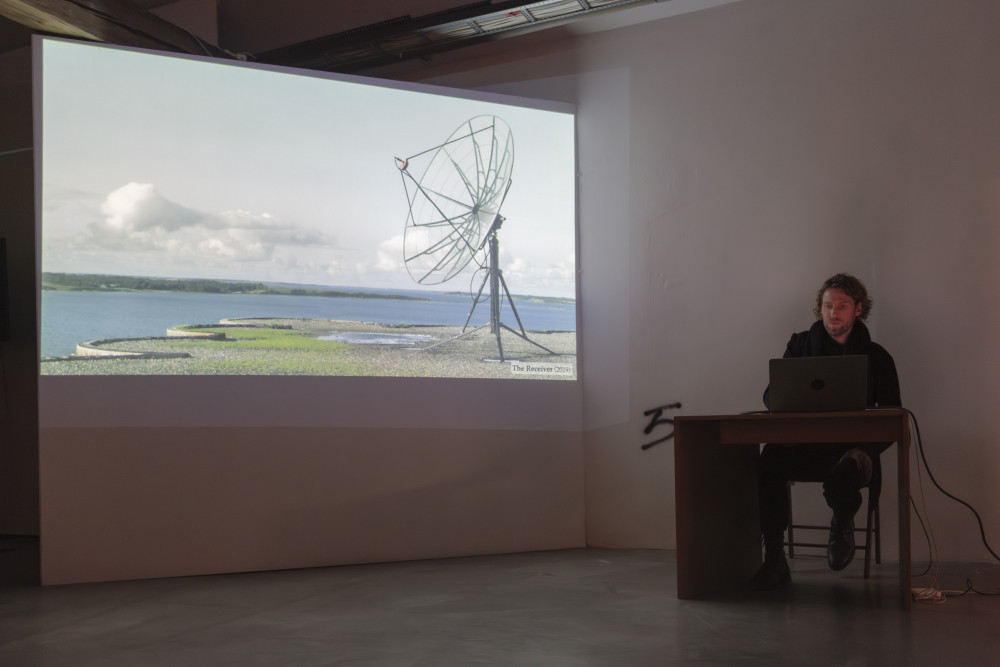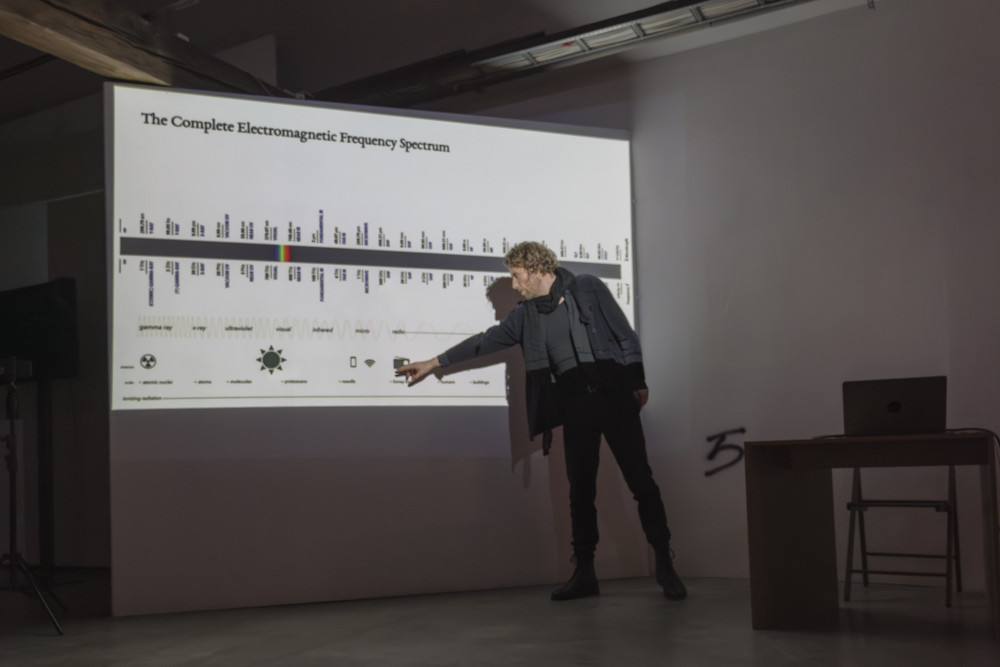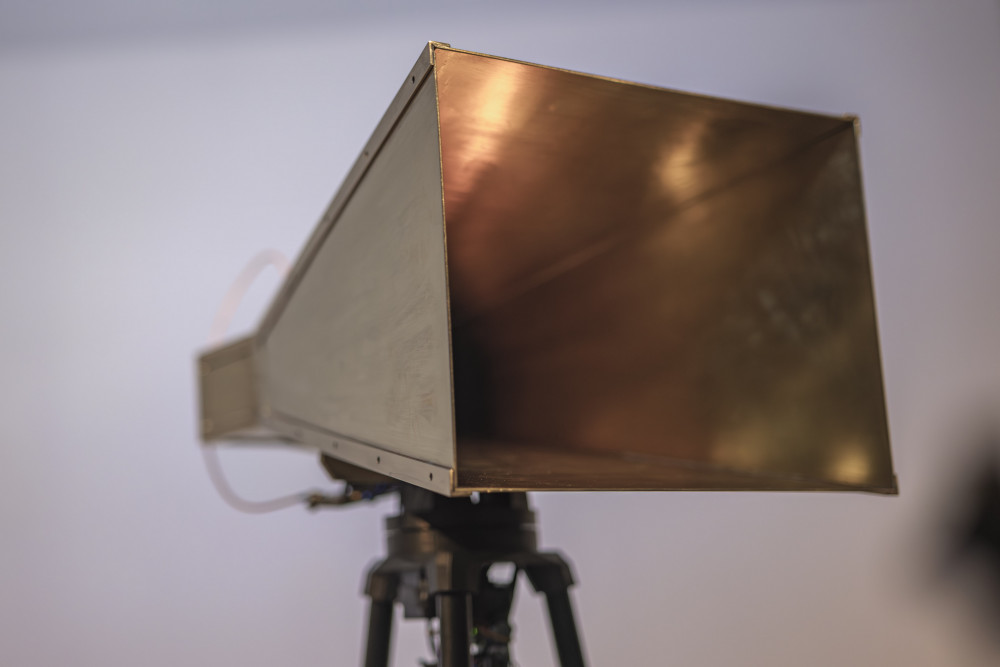SCAN is a kinetic sound installation that explores inaccessible phenomena from our immediate surroundings using advanced experimental detector technology, as an extension and exploration of human sensory and cognitive capacities.
SCAN employs an array of rotating detector systems that directionally capture and amplify signals in the microwave range.
This part of the electromagnetic spectrum — a region densely populated by human technologies — is highly versatile supporting a wide variety of communication and observation; from everyday technology (such as mobile phones, bluetooth, wifi) to advanced scientific studies (such as satellite communication, radar, and radio astronomy).
The project is a continuation of Skjødt Hasselstrøm’s artistic research and work. Where previous works have focused natural phenomena such as electromagnetic energy (ÆTER, 2017), radiation from the Sun (The Receiver, 2019), and cosmic rays (μ, 2022 and Myriads, 2024), Scan examines phenomena in our immediate surroundings that are created by human beings.
SCAN, however, differs significantly in its presentation through its inherent dual potential: while existing as a complete installation work, it can be ‘activated’, transforming the exhibition space into a live performative situation. This potential shift between states allows the work to operate on multiple experiential levels.
Materials: brass horn antennas, RF amplifier, custom analogue circuitry, motor, tripod, sound system
keywords: capacities of the human being, instrumental realism, post-phenomenology, entanglement, Anthropocene, (new) ecological awareness, detector, rotation, microwaves, sound.
###################################
In Dialogue:
Zuzana Jaworska (WRO Art Center) in conversation with Christian Skjødt Hasselstrøm
Zuzana Jaworska: What are you working on during the EMAP residency?
Christian Skjødt Hasselstrøm: During this residency at WRO Art Center I'm working on a new project called SCAN. Basically it's an array of rotating detectors that investigate or ‘scan’ our surroundings. Much of my previous work revolves around natural phenomena originating somewhat far away. In this work, however, near and human-generated material is being explored, as the installation receives microwave signals / radiation from our immediate environment. The microwave range is one of the areas of the electromagnetic spectrum where we human beings take up the most space; from everyday technology (such as mobile phones, bluetooth, wifi) to advanced scientific studies (such as satellite communication, radar, and radio astronomy). SCAN is an attempt to create a situation that grants us an access to some of this material. Material that is constantly all around us – and that we cannot perceive due to our limited capacities as human beings.
Zuzana Jaworska: That makes viewers’ interaction with your work very unique.
Christian Skjødt Hasselstrøm: One of the main interests of my artistic practice is to somehow situate the human being in a larger context – as to point towards both the interconnectedness as well as our position as a part of nature and not the dominating species. Underlining that our perception today is highly technologically mediated.
In my installations, there is often a kind of, well you could say, interactive element. However maybe interpassive might be more appropriate (hahaha). I'm not so much interested in creating instruments for the audience to play, or use, or have an interaction with. Instead I aim for and hope to create a situation and a space that explores the potential of extending or expanding our bodies and our cognition. And a maybe even a situation and a space of contemplation and reflection. A manifestation of or witness to what we as human beings are unable to perceive, where the installation acts almost like stoic sentinels of the boundaries between our sensory apparatus and the materiality of the world.
Zuzana Jaworska: Your projects are usually created for large-scale spaces. How do you choose the location?
Christian Skjødt Hasselstrøm: I primarily work site-specifically and I find working large-scale quite inspiring and full of potential. This aspect of my artistic practice kind of goes hand in hand with this notion of placing ourselves in a minor role, perhaps even as guests, in a larger context.
Often I am delighted to find myself in a situation in which I have the privilege of being offered exhibition spaces of a profound and, at times, almost sacred quality. However most important for me – concrete silo or white cube – I try to immerse myself into the actual space and understand its qualities. And I spend a lot of time to think about how to work with and not against the space. Furthermore, if you dare to introduce a sonic element into the space, it's essential to carefully consider with the acoustic signature and sonic qualities, as well as the visitors and potential species inhabiting the space.
Zuzana Jaworska: What is the process of creation of the SCAN? What are the steps?
Christian Skjødt Hasselstrøm: At the moment my team and I are at the end of the technical research phase of the project, and we are slowly moving into the next phase of more practical experimentation. At the same time, I'm working on developing the form and visuality of the installation, which is a highly iterative and pragmatic process of various experiments and prototypes before the final work sees the light of day. In the specific context of SCAN, we are currently experimenting with microwave reception, both in the design and construction of the antenna and in the development of the electronics. We are obviously putting a lot of time and energy into making sure that the system actually works. And to emphasize my strong focus on stability, durability and ease of operation, I try to avoid computers and other digital devices in the installations, using relatively simple analogue electronics instead, which all in all can be time-consuming, however quite rewarding in the end.



